In the realm of creative writing, one might assume that the human touch, with its irreplaceable intricacies of emotion, experience, and intuition, remains undisputed. However, the technological advancements of the 21st century have challenged this notion, presenting an unexpected contender in this domain --- artificial intelligence (AI).
Yes, ChatGPT gave me that introduction.
What you just read is a perfect example of how not to begin your article or blog post.
AI shouldn't be used in creative writing because it's not made to be creative. It's designed to be quite the opposite.
Language Models
I'm a data scientist working in research and development of Large Language Models. ChatGPT is a *Large Language Model. *The key is *autoregressive *--- meaning it predicts the next word based on the previous ones, one word at a time. The model looks at the sequence of words so far, and uses probability to guess what comes next.
Here's an example.
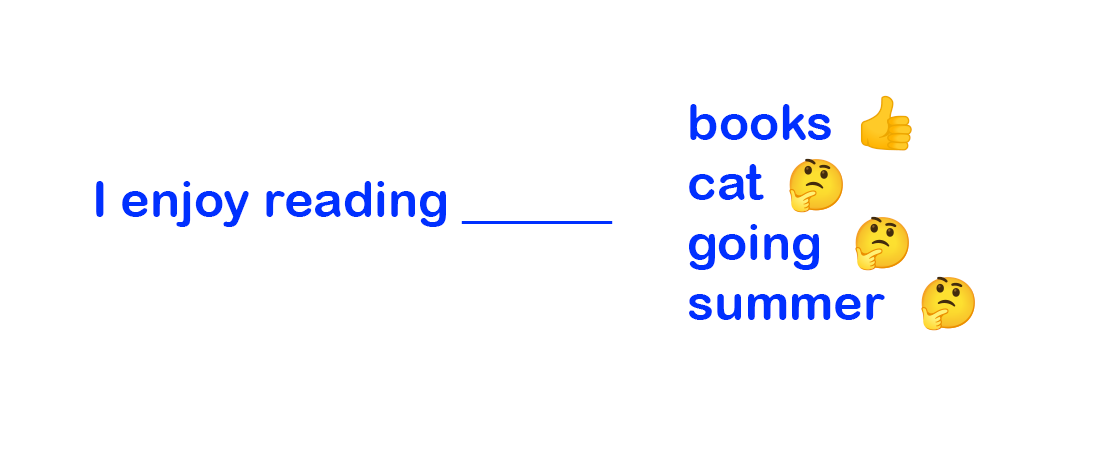
ChatGPT evaluates all the possible words to complete the sentence "I enjoy reading." The word "books" has the highest probability, so it's selected. Image by author.
In data science, we call perplexity a metric to measure how expected a word is in a text.
In the example, if you read I enjoy reading summer, you would feel perplexed about the word summer. Conversely, the word book is expected, so its perplexity is low. ChatGPT naturally prefers the words with lower perplexity.
While this process leads to perfect grammar and no typos, iterating it over long text sequences can lead to repetitive structures in the output text.
When you ask something to ChatGPT, its response would be the most likely text given your prompt.
I started from this idea and asked myself "What makes AI writing so boring?" and found some patterns.
The following screenshots are taken from ChatGPT, where I asked more or less the same prompt: generate an article about using AI in writing.
Repetitive sentences
When ChatGPT came out, I was amazed by how fluid and perfect its grammar was, but I quickly became tired of seeing the same things repeatedly.
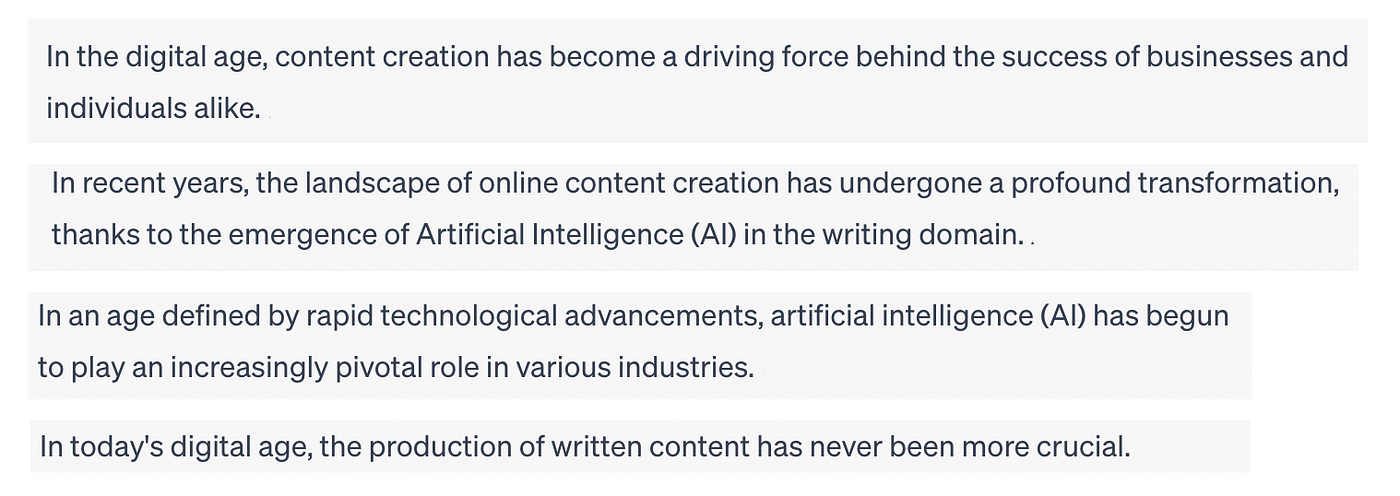
I'm sure you can think of a better introduction than this.
ChatGPT tends to structure text in bullet points. While bullet points can improve readability when used well, overusing them can make an article feel choppy and disjointed rather than smoothly flowing. It's better to use a mix of textual structures --- some bullet points for key takeaways, along with good paragraph structure to connect ideas and allow the writing to flow naturally. The goal should be an article that is organized but also reads smoothly from start to finish.
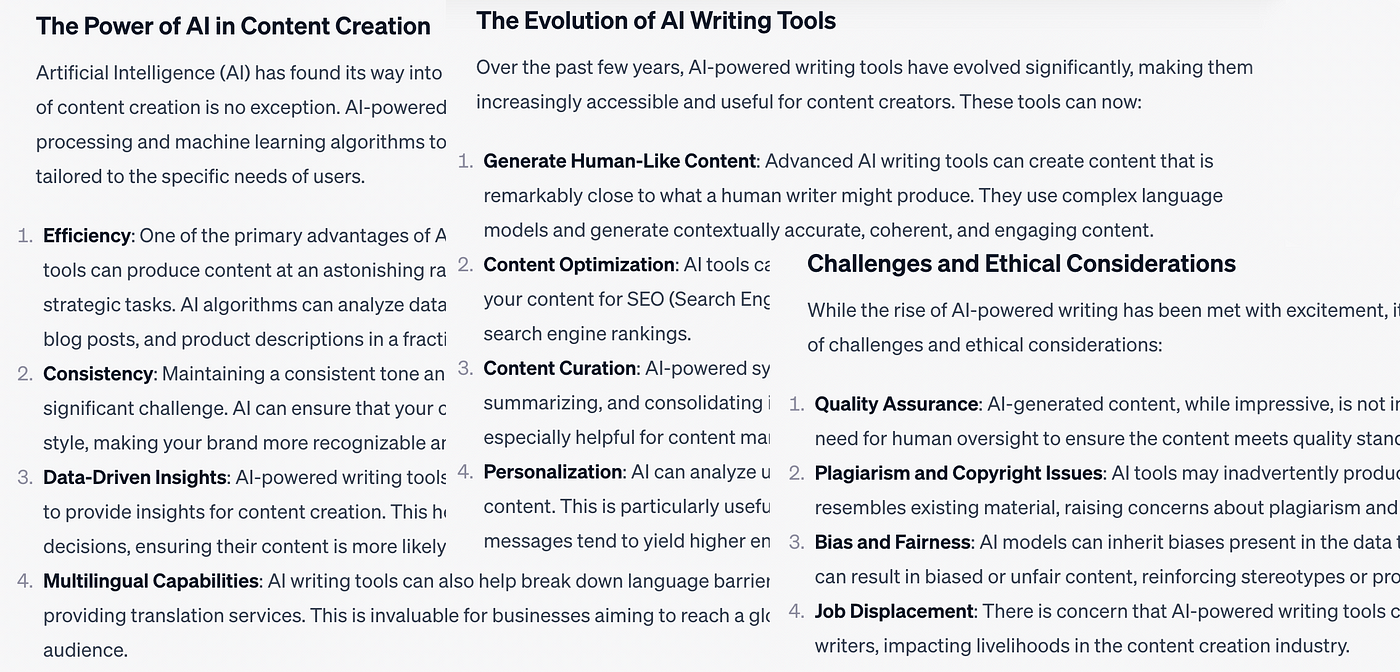
That's how I would structure my grocery list.
Rather than relying heavily on transition words like firstly, secondly, and in conclusion, it is better to structure your writing in a way that naturally guides the reader through your logic and reasoning. Overusing these types of transitions creates a formulaic, artificial feel. The reader should intrinsically understand the flow and progression of ideas without being explicitly told this is point one, point two, and so on. Allow the substance of your content to speak for itself and carry the reader along without having to announce each transition and new section. Your writing will feel more natural if you present your ideas in a logical order and help the reader follow your train of thought without having to spell it all out.

Words come in groups of three.
While using three examples can be an effective strategy in some cases, rigidly sticking to three examples for every point risks becoming predictable. Good writing should aim for some variability --- sometimes, one example makes the point eloquently, while other complex ideas may require more to illustrate fully.
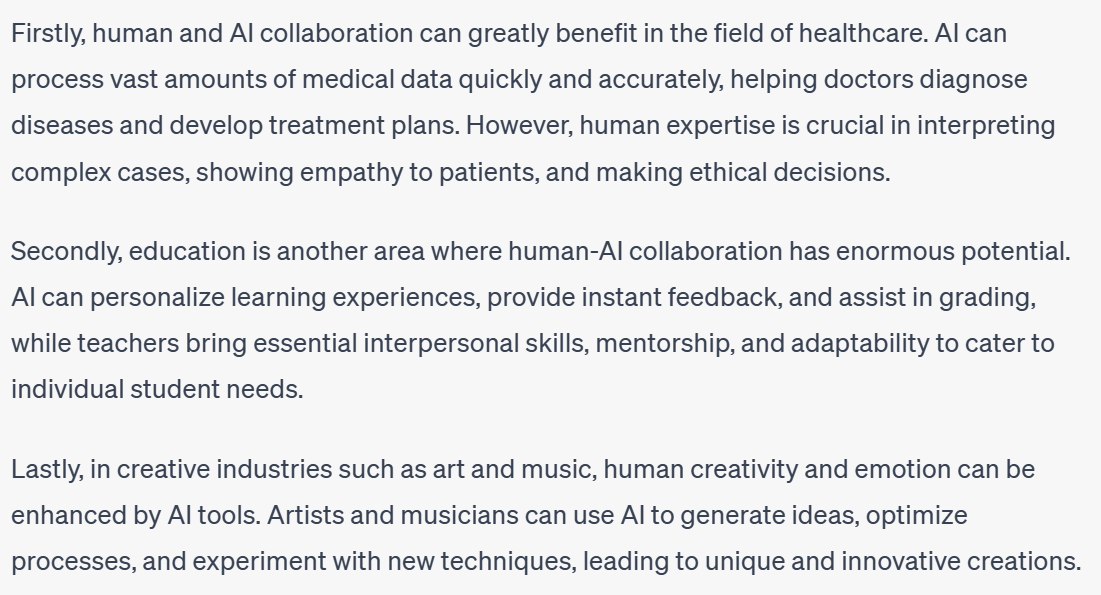
How not to structure your article.
AI text often relies on filler phrases that sound sophisticated but add little substance. For example, stating the importance of something using it's essential/crucial/imperative/vital is vague and overused. Active verbs such as *harnessing, unlocking, and unleashing *can also feel hollow without clear context.
Passive voices and long sentences
ChatGPT can sometimes generate very long, complex sentences in its responses. While a few longer sentences are okay, too many convoluted sentences can make text difficult to read. It is generally best to aim for an average sentence length of 15--20 words for maximum readability. Shorter sentences allow readers to grasp key ideas and follow the flow of thought easily. Using too many wordy sentences risks losing the reader's attention and compromising comprehension. We can create clear and readable text by editing responses to break up lengthy sentences. The goal should be variety in sentence structure, with some short, punchy sentences and some longer ones for elaboration, while avoiding dense blocks of text.

Long sentences with many unnecessary words.
These are all repetitive structures that we're now used to see in every AI-generated text.
While these language patterns give the impression of coherent writing, overusing them results in text lacking originality and depth. The most engaging writing draws readers in with unique insights and skillful linking of concepts.
Read books by your favorite authors. How often do they use these structures? I bet you won't find many of them.
Also, quality writing has opinions. AI text is like, with A and B, here's a neutral conclusion.
Prompt engineering doesn't help
Prompt engineering is when people carefully choose words to give AI instructions. The words they choose help the AI understand precisely what to do. Prompt engineers pick prompts that will get the best results from the AI. But we cannot use prompt engineering to overcome all of AI's limitations.
Don't get me wrong, prompt engineering is great, just not in the context of creative writing.
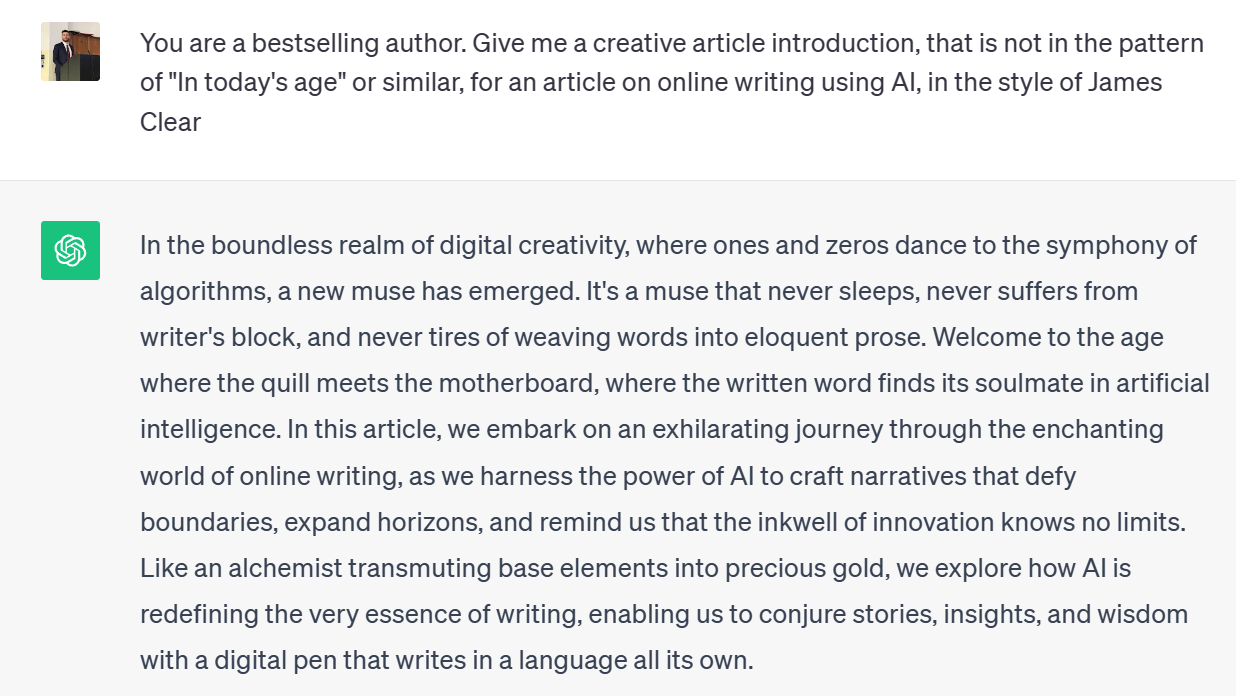
Making it even worse with prompt engineering.
An AI writing system is like an orchestra of musicians. The prompter is like the conductor, directing the musicians with gestures and instructions. But no matter how animated the conductor is, the orchestra can only play the instruments they hold.
The prompt can guide the AI, but the AI's creativity is limited by its inner architecture and training data.
An orchestra of only violins, however masterfully conducted, will never sound like an entire symphony. Prompt engineering alone is like asking a lone violinist to perform Beethoven's Fifth Symphony.
Use AI tools for tasks where following rigid structures and rules is advantageous. This is where ChatGPT's autoregressive nature shines.
Here are some of my favorites.
Summarization
A recent study showed that GPT is better at summarization than humans. I use it to summarize long text and extract insights in structured bullet points.
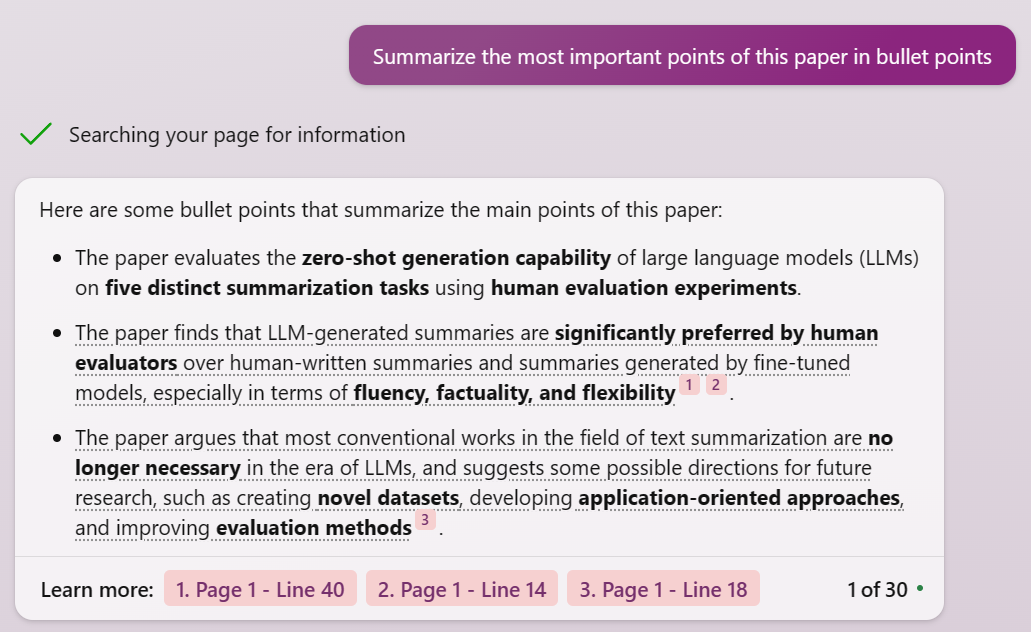
When delivering information, the structured text is great. I use Bing AI to generate summaries of research papers.
Another idea for summarization is combining the usage of transcription and ChatGPT. Have an hour-long meeting or lecture recorded? Just transcribe it (I use Whisper), feed the raw transcription to ChatGPT, and ask for a summary.
Sentence rewriting
As a non-native speaker, I struggle to have a diverse word choice, so I like using this prompt asking to rewrite sentences --- reading the variations teaches me different writing styles.

Generating variation of a human-written sentence.
OCR
ChatGPT can now read images thanks to the recent launch of GPT4V, so if pen and paper are your preferred notetaking methods, you'll be stunned that you can write, take a shot, and have it translated to text.

It works well even with very hard-to-read text. Image source.
A lesson on good writing
Writing well has always been challenging, but I improved by analyzing AI-generated content. It's often criticized as monotonous and boring, and most Medium readers are against artificial writing. In this piece, I aimed to pinpoint what makes it bad based on my experience developing large language models as a data scientist.
AI-generated content tends to be repetitive and uninspired. It is best not to rely on it for creative content or ideas, even with careful prompt engineering, as it simply does not deliver.
Consider using AI tools for particular tasks like summarization or repetitive ones.